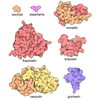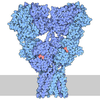+ Open data
Open data
- Basic information
Basic information
| Entry | Database: PDB / ID: 9omp | ||||||
|---|---|---|---|---|---|---|---|
| Title | mGluR7 in native membrane vesicles | ||||||
 Components Components | Metabotropic glutamate receptor 7 | ||||||
 Keywords Keywords | MEMBRANE PROTEIN / GPCR / Class C / cluster | ||||||
| Function / homology |  Function and homology information Function and homology informationgroup III metabotropic glutamate receptor activity / adenylate cyclase-inhibiting G protein-coupled glutamate receptor signaling pathway / : / negative regulation of glutamate secretion / serine binding / G protein-coupled glutamate receptor signaling pathway / Class C/3 (Metabotropic glutamate/pheromone receptors) / glutamate receptor activity / presynaptic active zone / glutamate binding ...group III metabotropic glutamate receptor activity / adenylate cyclase-inhibiting G protein-coupled glutamate receptor signaling pathway / : / negative regulation of glutamate secretion / serine binding / G protein-coupled glutamate receptor signaling pathway / Class C/3 (Metabotropic glutamate/pheromone receptors) / glutamate receptor activity / presynaptic active zone / glutamate binding / axon development / asymmetric synapse / regulation of synaptic transmission, glutamatergic / adenylate cyclase inhibitor activity / dendritic shaft / PDZ domain binding / sensory perception of sound / adenylate cyclase-inhibiting G protein-coupled receptor signaling pathway / cell cortex / G alpha (i) signalling events / chemical synaptic transmission / postsynaptic membrane / receptor complex / protein dimerization activity / axon / calcium ion binding / dendrite / membrane / plasma membrane Similarity search - Function | ||||||
| Biological species |  Homo sapiens (human) Homo sapiens (human) | ||||||
| Method | ELECTRON MICROSCOPY / single particle reconstruction / cryo EM / Resolution: 4.3 Å | ||||||
 Authors Authors | Mandala, V. / Fu, Z. / MacKinnon, R. | ||||||
| Funding support |  United States, 1items United States, 1items
| ||||||
 Citation Citation |  Journal: Proc Natl Acad Sci U S A / Year: 2025 Journal: Proc Natl Acad Sci U S A / Year: 2025Title: Molecular contacts in self-assembling clusters of membrane proteins. Authors: Venkata Shiva Mandala / Ziao Fu / Roderick MacKinnon /  Abstract: Motivated by recent data pointing to the existence of homo-oligomeric assemblies of membrane proteins called higher-order transient structures, and their apparent role in connecting components of ...Motivated by recent data pointing to the existence of homo-oligomeric assemblies of membrane proteins called higher-order transient structures, and their apparent role in connecting components of membrane signal pathways, we examine here by cryoelectron microscopy some of the protein-protein interactions that occur in cluster formation. Metabotropic glutamate receptors and HCN ion channels inside clusters contact their neighbors through structured extracellular and intracellular domains, respectively. Other ion channels, including Kv2.1 and Slo1, appear to form clusters through prominent intrinsically disordered sequences in the cytoplasm. These distinct modes of interaction are associated with clusters exhibiting varying degrees of compactness and order. We conclude that nature utilizes a variety of ways to form connections between membrane proteins in self-assembled clusters. | ||||||
| History |
|
- Structure visualization
Structure visualization
| Structure viewer | Molecule:  Molmil Molmil Jmol/JSmol Jmol/JSmol |
|---|
- Downloads & links
Downloads & links
- Download
Download
| PDBx/mmCIF format |  9omp.cif.gz 9omp.cif.gz | 601.5 KB | Display |  PDBx/mmCIF format PDBx/mmCIF format |
|---|---|---|---|---|
| PDB format |  pdb9omp.ent.gz pdb9omp.ent.gz | 414.4 KB | Display |  PDB format PDB format |
| PDBx/mmJSON format |  9omp.json.gz 9omp.json.gz | Tree view |  PDBx/mmJSON format PDBx/mmJSON format | |
| Others |  Other downloads Other downloads |
-Validation report
| Arichive directory |  https://data.pdbj.org/pub/pdb/validation_reports/om/9omp https://data.pdbj.org/pub/pdb/validation_reports/om/9omp ftp://data.pdbj.org/pub/pdb/validation_reports/om/9omp ftp://data.pdbj.org/pub/pdb/validation_reports/om/9omp | HTTPS FTP |
|---|
-Related structure data
| Related structure data |  70615MC  9omoC M: map data used to model this data C: citing same article ( |
|---|---|
| Similar structure data | Similarity search - Function & homology  F&H Search F&H Search |
- Links
Links
- Assembly
Assembly
| Deposited unit | 
|
|---|---|
| 1 |
|
- Components
Components
| #1: Protein | Mass: 102834.938 Da / Num. of mol.: 2 Source method: isolated from a genetically manipulated source Source: (gene. exp.)  Homo sapiens (human) / Gene: GRM7, GPRC1G, MGLUR7 / Production host: Homo sapiens (human) / Gene: GRM7, GPRC1G, MGLUR7 / Production host:  Homo sapiens (human) / References: UniProt: Q14831 Homo sapiens (human) / References: UniProt: Q14831Has protein modification | Y | |
|---|
-Experimental details
-Experiment
| Experiment | Method: ELECTRON MICROSCOPY |
|---|---|
| EM experiment | Aggregation state: PARTICLE / 3D reconstruction method: single particle reconstruction |
- Sample preparation
Sample preparation
| Component | Name: mGLuR7 / Type: COMPLEX / Entity ID: all / Source: RECOMBINANT |
|---|---|
| Molecular weight | Experimental value: NO |
| Source (natural) | Organism:  Homo sapiens (human) Homo sapiens (human) |
| Source (recombinant) | Organism:  Homo sapiens (human) Homo sapiens (human) |
| Buffer solution | pH: 7.4 |
| Specimen | Embedding applied: NO / Shadowing applied: NO / Staining applied: NO / Vitrification applied: YES |
| Vitrification | Cryogen name: ETHANE |
- Electron microscopy imaging
Electron microscopy imaging
| Experimental equipment |  Model: Titan Krios / Image courtesy: FEI Company |
|---|---|
| Microscopy | Model: TFS KRIOS |
| Electron gun | Electron source:  FIELD EMISSION GUN / Accelerating voltage: 300 kV / Illumination mode: FLOOD BEAM FIELD EMISSION GUN / Accelerating voltage: 300 kV / Illumination mode: FLOOD BEAM |
| Electron lens | Mode: BRIGHT FIELD / Nominal defocus max: 20000 nm / Nominal defocus min: 10000 nm |
| Image recording | Electron dose: 42 e/Å2 / Film or detector model: FEI FALCON IV (4k x 4k) |
- Processing
Processing
| CTF correction | Type: PHASE FLIPPING AND AMPLITUDE CORRECTION | ||||||||||||||||||||||||
|---|---|---|---|---|---|---|---|---|---|---|---|---|---|---|---|---|---|---|---|---|---|---|---|---|---|
| 3D reconstruction | Resolution: 4.3 Å / Resolution method: FSC 0.143 CUT-OFF / Num. of particles: 498211 / Symmetry type: POINT | ||||||||||||||||||||||||
| Refinement | Cross valid method: NONE Stereochemistry target values: GeoStd + Monomer Library + CDL v1.2 | ||||||||||||||||||||||||
| Displacement parameters | Biso mean: 76.99 Å2 | ||||||||||||||||||||||||
| Refine LS restraints |
|
 Movie
Movie Controller
Controller






 PDBj
PDBj

